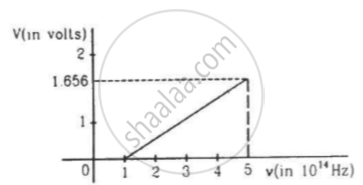Advertisements
Advertisements
प्रश्न
Consider a 20 W bulb emitting light of wavelength 5000 Å and shining on a metal surface kept at a distance 2 m. Assume that the metal surface has work function of 2 eV and that each atom on the metal surface can be treated as a circular disk of radius 1.5 Å.
- Estimate no. of photons emitted by the bulb per second. [Assume no other losses]
- Will there be photoelectric emission?
- How much time would be required by the atomic disk to receive energy equal to work function (2 eV)?
- How many photons would atomic disk receive within time duration calculated in (iii) above?
- Can you explain how photoelectric effect was observed instantaneously?
उत्तर
According to the problem, P = 20 W, λ = 5000 Å = 5000 × 10–10 m, distance (d) = 2 m, work function `phi_0` = 2 eV, radius r = 1.5 Å = 1.5 × 10–10 m
Now, Number of photon emitted by bulb per second, n' = `(dN)/(dt)`
i. Number of photon emitted by bulb per second is n’ = `(P)/((hc)/λ) = (Pλ)/(hc)`
= `(20 xx (5000 xx 10^-10))/((6.62 xx 10^-34) xx (3 xx 10^8))`
⇒ n' = 5 × 1019/sec
ii. Energy of the incident photon = `(hc)/λ`
= `((6.62 xx 10^-34) xx (3 xx 10^8))/(5000 xx 10^-10 xx 1.6 xx 10^-19)`
= 2.48 ev
As this energy is greater than 2 eV (i.e., a work function of the metal surface), hence photoelectric emission takes place.
iii. Let Δt be the time spent in getting the energy `phi` = (work function of metal).

Consider the figure, if P is the power of source then energy received by the atomic disc
`p/(4πd^2) xx pir^2Δt = phi_0`
⇒ Δt = `(4phi_0d^2)/(Pr^2)`
= `(4 xx (2 xx 1.6 xx 10^-19) xx 2^2)/(20 xx (1.5 xx 10^-10)^2`
= 2.84 s
iv. Number of photons received by the atomic disc in time Δt is
N = `(n^' xx pir^2)/(4pid^2) xx Δt`
= `(n^'r^2Δt)/(4d^2)`
= `((5 xx 10^19) xx (1.5 xx 10^-10)^2 xx 28.4)/(4 xx (2)^2`
= 2
Now let us discuss the last part in detail. As the time of emission of electrons is 11.04 s.
v. In photoelectric emission, there is a collision between the incident photon and free electron of the metal surface, which lasts for a very short interval of time (≈ 10–9 s), hence we say photoelectric emission is instantaneous.
APPEARS IN
संबंधित प्रश्न
Light of intensity 10−5 W m−2 falls on a sodium photo-cell of surface area 2 cm2. Assuming that the top 5 layers of sodium absorb the incident energy, estimate time required for photoelectric emission in the wave-picture of radiation. The work function for the metal is given to be about 2 eV. What is the implication of your answer?
It is found that yellow light does not eject photoelectrons from a metal. Is it advisable to try with orange light or with green light?
When the intensity of a light source in increased,
(a) the number of photons emitted by the source in unit time increases
(b) the total energy of the photons emitted per unit time increases
(c) more energetic photons are emitted
(d) faster photons are emitted
Photoelectric effect supports quantum nature of light because
(a) there is a minimum frequency below which no photoelectrons are emitted
(b) the maximum kinetic energy of photoelectrons depends only on the frequency of light and not on its intensity
(c) even when the metal surface is faintly illuminated the photoelectrons leave the surface immediately
(d) electric charge of the photoelectrons is quantised
A photon of energy hv is absorbed by a free electron of a metal with work-function hv − φ.
Calculate the momentum of a photon of light of wavelength 500 nm.
(Use h = 6.63 × 10-34J-s = 4.14 × 10-15 eV-s, c = 3 × 108 m/s and me = 9.1 × 10-31kg)
A small piece of cesium metal (φ = 1.9 eV) is kept at a distance of 20 cm from a large metal plate with a charge density of 1.0 × 10−9 C m−2 on the surface facing the cesium piece. A monochromatic light of wavelength 400 nm is incident on the cesium piece. Find the minimum and maximum kinetic energy of the photoelectrons reaching the large metal plate. Neglect any change in electric field due to the small piece of cesium present.
(Use h = 6.63 × 10-34J-s = 4.14 × 10-15 eV-s, c = 3 × 108 m/s and me = 9.1 × 10-31kg)
The figure is the plot of stopping potential versus the frequency of the light used in an experiment on photoelectric effect. Find (a) the ratio h/e and (b) the work function.

Explain how does (i) photoelectric current and (ii) kinetic energy of the photoelectrons emitted in a photocell vary if the frequency of incident radiation is doubled, but keeping the intensity same?
Show the graphical variation in the above two cases.
If photons of ultraviolet light of energy 12 eV are incident on a metal surface of work function of 4 eV, then the stopping potential (in eV) will be :
